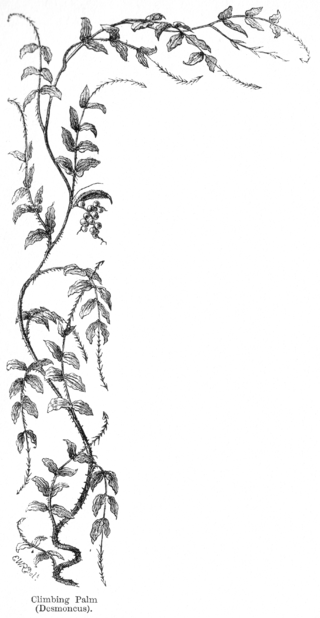
Chusquea is a genus of evergreen bamboos in the grass family. Most of them are native to mountain habitats in Latin America, from Mexico to southern Chile and Argentina.

Pouteria is a genus of flowering trees in the gutta-percha family, Sapotaceae. The genus is widespread throughout the tropical Americas, with outlier species in Cameroon and Malesia. It includes the canistel, the mamey sapote, and the lucuma. Commonly, this genus is known as pouteria trees, or in some cases, eggfruits.

Weinmannia is a genus of trees and shrubs in the family Cunoniaceae. It contains 90 species, which range from Mexico through Central and South America including the Caribbean, and to the Mascarene Islands in the western Indian Ocean. It is absent from mainland Africa and Australia, but some fossils have been attributed to Weinmannia in Australia.

Desmoncus is a genus of mostly climbing, spiny palms native to the Neotropics. The genus extends from Mexico in the north to Brazil and Bolivia in the south, with two species present in the southeastern Caribbean.

The black-tailed myiobius or black-tailed flycatcher is a species of passerine bird in the family Tityridae. It was previously placed in the family Tyrannidae. Black-tailed flycatchers are found in Brazil, Colombia, Costa Rica, Ecuador, Panama, Peru, and Venezuela. Their natural habitats are subtropical or tropical moist lowland forests and heavily degraded former forest. They are usually found alone or in pairs, but may join flocks of several species.

Arsenura sylla is a moth of the family Saturniidae first described by Pieter Cramer in 1779. It is found from Venezuela south to Mato Grosso, Brazil and then west to Bolivia.
Neopostega distola is a moth of the family Opostegidae. It is known only from south-western Brazil and northern Costa Rica.
Pseudopostega rotunda is a moth of the family Opostegidae. It is found known from the lowland forest of the La Selva Biological Reserve in north-eastern Costa Rica, the Guanacaste Province in north-western Costa Rica and the Napo Province in east-central Ecuador.
Pseudopostega serrata is a moth of the family Opostegidae. It is widespread in Costa Rica up to elevations of 1,520 meters. It has also been recorded from Ecuador and southern Panama.
Pseudopostega adusta is a moth of the family Opostegidae. It was described by Walsingham, Lord Thomas de Grey, in 1897. It is known from the West Indies, from Cuba east to Dominica, south to Belize and Ecuador. It is also known from Costa Rica.
Pseudopostega saltatrix is a moth of the family Opostegidae. It was described by Walsingham, Lord Thomas de Grey, in 1897. It was described from St. Thomas, in the Virgin Islands, but has an extremely wide range, from Cuba to Dominica in the West Indies, south from Belize to Ecuador, French Guiana and Paraguay.
Pseudopostega dorsalis is a moth of the family Opostegidae. It was described by Donald R. Davis and Jonas R. Stonis, 2007. It is known from Costa Rica.
Pseudopostega duplicata is a moth of the family Opostegidae. It was described by Donald R. Davis and Jonas R. Stonis, 2007. It is known from Costa Rica and Tortola in the British Virgin Islands.
Pseudopostega latiapicula is a moth of the family Opostegidae. It was described by Donald R. Davis and Jonas R. Stonis, 2007. It is known from the La Selva Biological Station of north-eastern Costa Rica and the state of Paraná in north-eastern Brazil.
Pseudopostega latifurcata is a moth of the family Opostegidae. It was described by Donald R. Davis and Jonas R. Stonis, 2007. It is known from Puerto Rico, the Virgin Islands, Dominica and Costa Rica.
Pseudopostega sublobata is a moth of the family Opostegidae. It was described by Donald R. Davis and Jonas R. Stonis, 2007. It is known from Costa Rica and Ecuador.
Pseudopostega tanygnatha is a moth of the family Opostegidae. It was described by Donald R. Davis and Jonas R. Stonis, 2007. It is known from north-western Costa Rica
Pseudopostega robusta is a moth of the family Opostegidae. It was described by Andrius Remeikis and Jonas R. Stonis in 2009. It is known from the Pacific Coast of Costa Rica.

Enyo taedium is a species of moth in the family Sphingidae. It was described by Schaus, in 1890.

Rhytidochrotinae is a subfamily of grasshoppers from the family Acrididae with 20 genera and 47 species. This group is found from southern Central America to northern South America with most species distributed in montane forests. The highest concentration of species are found on the Pacific coast and in the West Andes of Colombia with 11 genera and 23 species registered. Many are brightly colored in reds, especially males, and most species are apterous.







